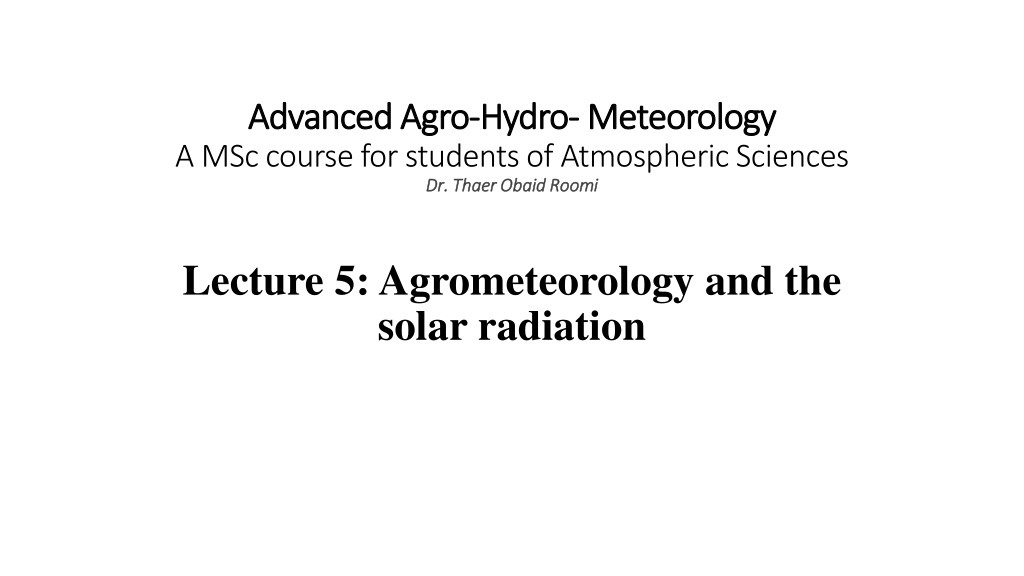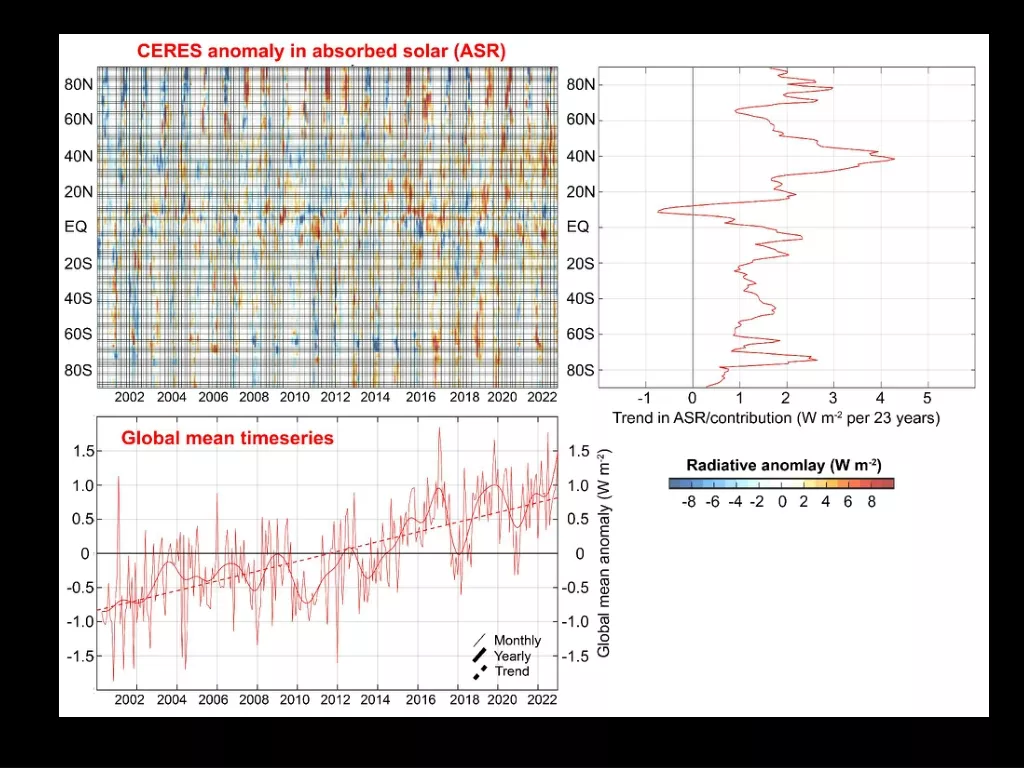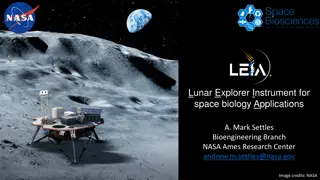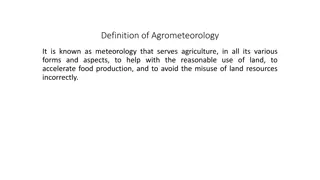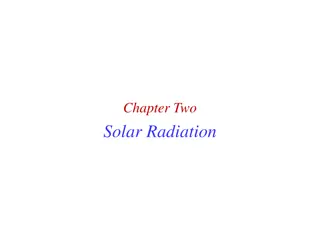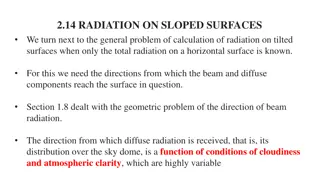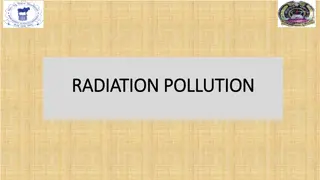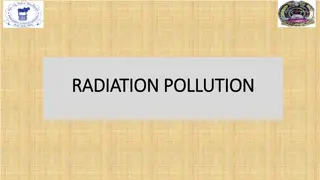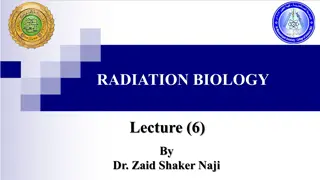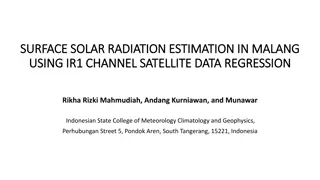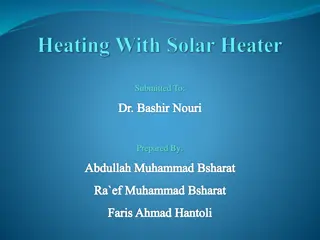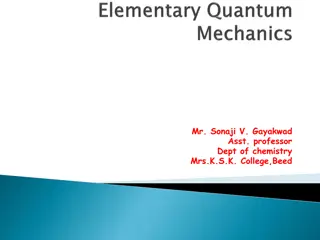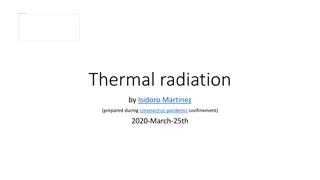Agrometeorology and Solar Radiation
Agrometeorology is a branch of applied meteorology focusing on the environment of plants and animals, exploring the impact of weather conditions on agriculture. It plays a vital role in strategic and tactical decision-making for crop development. Understanding solar radiation reaching the Earth's surface is crucial for agricultural processes, with variations depending on location, time, and atmospheric conditions. Learn about the roles of agrometeorology and the annual losses in agriculture due to various weather effects and other factors.
Download Presentation

Please find below an Image/Link to download the presentation.
The content on the website is provided AS IS for your information and personal use only. It may not be sold, licensed, or shared on other websites without obtaining consent from the author.If you encounter any issues during the download, it is possible that the publisher has removed the file from their server.
You are allowed to download the files provided on this website for personal or commercial use, subject to the condition that they are used lawfully. All files are the property of their respective owners.
The content on the website is provided AS IS for your information and personal use only. It may not be sold, licensed, or shared on other websites without obtaining consent from the author.
E N D
Presentation Transcript
Advanced Agro Advanced Agro- -Hydro A MSc course for students of Atmospheric Sciences Dr. Thaer Obaid Roomi Dr. Thaer Obaid Roomi Hydro- -Meteorology Meteorology Lecture 5: Agrometeorology and the solar radiation
Agrometeorology 5.1 Agrometeorology Definition: It is a branch of applied meteorology which investigates the physical conditions of the environment of growing plants or animal organisms. It deals with the relationship between weather/climatic conditions and agricultural production. The aim of agricultural meteorology is to make use of the science of meteorology in the interest of food production. Agriculture Soil Plant Atmosphere Meteorological Dangers Frost drought soil erosion pollution Forest fires
The roles of Agrometeorology Strategical assessment of long-term utilization of natural resources in the development of crop diversity Tactical concerned with the short-term and field-scale decisions that directly influence crop growth and development.
Annual loses in agriculture Weather effects: drought, flash floods, untimely rains, frost, hail, and storms Other: Losses in harvest and storage, parasites, insects, and plant diseases
5.2 The solar energy reaching the earths surface The solar constant is the flux of radiation at the outer boundary of the atmosphere, received on a surface held perpendicular to the sun s direction at the mean distance between the sun and the earth. The value of the solar constant is 1,370 W m 2 1370 (100%) 43 % is absorbed by 31 % is scattered back to space 26% absorbed by the atmosphere the earth s surface
The irradiation amount at the earths surface is not uniform, the annual value at the equator is 2.4 times that near the poles. The solar energy incident upon a surface depends on the geographic location, orientation of the surface, time of the day, time of the year, and atmospheric conditions.
radiation radiation Every item of matter with a temperature above absolute zero emits radiation Substances that emit the maximum amount of radiation in all wavelengths are known as black bodies. Such bodies will absorb all radiation incident upon them. A black body is thus a perfect radiator and absorber. The wavelengths at which energy is emitted by substances depend on their temperature- the higher the temperature, the shorter the wavelength.
Planks quantum theory In 1900 Max Plank proposed Quantum Theory. This theory explains the nature of black body radiation . The black body absorbs all the radiation falling on it. It is not only a perfect absorber but also a perfect radiator emits radiant energy. The nature of radiation emitted by BB depends upon its temperature. As the temperature increases, the peak of the curve shifts toward the lower wavelengths. Postulates of Plank s theory The emission of radiation is due to vibration of charged particles (electrons) in the body. The emission is not continuous but in discrete packets of energy called Quanta . The emitted radiation propagates in the form of waves. The energy E associated with each quantum for a particular radiation of frequency is given by: E= h where h=6.625 10-34 j/sec
Kirchhoff s Law This law states that the absorptivity a of an object (black or gray) for radiation of a specific wavelength is equal to its emissivity e for the same wavelength. The equation of the law is Good absorbers are good emitters ?(?) = ?(?) It s a form of the first law of thermodynamics Stefan-Boltzmann Law It states that the intensity of radiation emitted by a radiating body is proportional to the fourth power of the absolute temperature of that body: ???? = ? ?? {Flux= power/area = energy/(time area)} is the Stefan-Boltzmann constant (5.67 10 8 W m 2 K 4) Wein s Law The wavelength of maximum intensity of emission from a black body is inversely proportional to the absolute temperature (T) of the body. Thus, 2897 ? ????????? ?? ??????? ????????? ?? = For the sun, ???? is near 0.5 ?? and is in the visible spectrum.
Beer and Lambert s Laws Beer law states that concentration and absorbance are directly proportional to each other. Lambert law states that absorbance and path length are directly proportional. The intensity according Beer-Lambert law equation ? = ?? ? ? ? where Io represents initial intensity (here the solar constant) , is the absorbance coefficient, and ? represents distance of the air transverse.
When incident radiation interacts with matter (solid, liquid, or gas) can change the following properties of incident radiation: (1) intensity, (2) direction, (3) wavelength, (4) polarization, and (5) phase. ?? = ?? + ?? + ?? + ?? + (? + ?)(1 ?) + (? + ?) ? Qs is the incident Cr is reflection and scattering back to space by clouds Ca is absorption by clouds Aa is absorption by air, dust, and water vapors (Q + q) (1 a)is absorption by the earth s surface (Q + q)a is reflection by the earth
The atmosphere absorbs about 20% of the solar radiation Significant absorbers are: O and O2 <0.1 m O3 0.1<wavelengths<0.3 m CO2 Strong around 15 m H2O Strong absorbance around 6 m. where almost 100 % of longwave radiation may be absorbed if the atmosphere is sufficiently moist.
Albedo Albedo Albedo -- About 6 % of the solar radiation that reaches the earth is reflected back to space. The albedo varies with the color and composition of the earth s surface, the season, and the angle of the sun s rays.
Outgoing longwave radiation The earth s surface after being heated by solar radiation becomes a source of radiation itself. Because the average temperature of the earth s surface is about 285 K. 99 % of the radiation is emitted in the IR range from 4 to 120 m, with a peak near 10 m, as indicated by Wein s displacement law. This is longwave radiation and is also known as terrestrial radiation.
The earths atmosphere absorbs about 90 % of the outgoing radiation from the earth s surface. Water vapors absorb in wavelengths of 5.3 to 7.7 m and beyond 20 m; ozone in wavelengths of 9.4 to 9.8 m; carbon dioxide in wavelengths of 13.1 to 16.9 m; Clouds in all wavelengths. Longwave radiation escapes to space between 8.5 and 11.0 m, known as the atmospheric window. A large part of the radiation absorbed by the atmosphere is sent back to the earth s surface as counter radiation. This counter radiation prevents the earth s surface from excessive cooling at night.
Solar radiation and crop plants Crop production is in fact an exploitation of solar radiation. The three broad spectra of solar energy are significant to plant life. UV is chemically very active and be detrimental if it is excessive. The atmosphere prevents most of this type of solar radiation from reaching earth. The reaching UV is very low and is normally tolerated by plants. IR segment has thermal effects on plants. In the presence of water vapors, this radiation does not harm plants; rather, it supplies the necessary thermal energy to the plant environment. VIS part (light) plays an important part in plant growth and development through the processes of chlorophyll synthesis and photosynthesis and through photosensitive regulatory mechanisms such as phototropism and photoperiodic activity. Light of the correct intensity, quality, and duration is essential for normal plant development. It affects the production of tillers; the stability, strength, and length of the culms; the yield and total weight of plant structures; and the size of leaves and root development. The length of day or the duration of the light period determines flowering and has a profound effect on the content of soluble carbohydrates present.
Reflection Reflection, Transmission, and Absorption , Transmission, and Absorption Reflection and transmission from the leaves have similar spectral distributions as shown in the figures. The maxima for both are in the green light as well as in the infrared region. The impression of the green color of the plants depends on the high reflectivity, the relatively high intensity of solar radiation, and the greater sensitivity of the human eye for green light. The strong infrared reflection from plants is an important natural device for protection of plant life against damage due to overheating. On average, the plant canopy absorbs about 75 % of the incident radiation, with about 15 % reflected and 10 % transmitted.
Due to their chemical components or physical structures, plants absorb selectively in discrete wavelengths. The transparent epidermis allows the incident sunlight to penetrate into the mesophyll, which consists of two layers: (1) the palisade parenchyma of closely spaced cylindrical cells and (2) the spongy parenchyma of irregular cells with abundant interstices filled with air. Both types of mesophyll cells contain chlorophyll, blue and red energy for photosynthesis. Chlorophyll absorption is maximum in the blue (0.45 m) and in the red (0.65 m) regions. The longer wavelengths of photographic IR energy penetrate into the spongy parenchyma, where the energy is strongly scattered and reflected by the boundaries between the cell walls and air spaces. The high near-infrared reflectance of leaves is caused by the internal cell structure. Near the border of visible light, absorption by the plant decreases but then increases again in the infrared. Infrared radiation greater than 3 m is completely absorbed by the plants.
It can be summed up that the plant leaf strongly absorbs blue and red wavelengths, less strongly absorbs the green, very weakly absorbs the near infrared, and strongly absorbs in the far-infrared wavelengths. Because the absorption of the near-infrared wavelengths by the leaf is limited, by discarding this energy it prevents the internal temperature from becoming lethal. At the infrared wavelengths, the plant leaf is an efficient absorber, but in these wavelengths the energy at the surface is small, with the result that the plant is a good absorber in the far-infrared. It is an equally a good radiator at these wavelengths. The quality of radiation affects flowering, germination, and elongation. The visible part of the spectrum also influences the orientation of shoots, phenomenon known as phototropism. When shoots turn toward the light, the phenomenon is known as positive phototropism. With increasing intensity of light, positive phototropism turns into negative phototropism. The strongest influence on phototropism is by the blue part of the spectrum (0.5 m) and the weakest influence is by red rays. Very little of ultraviolet part of the spectrum reaches the earth s surface but it has biological effects. This type of rays may kill microorganisms, disinfect the soil, and eradicate diseases. Ultraviolet rays also influence the germination and quality of seeds. Ultraviolet radiation leads to a strong inhibition of photosynthesis and metabolism.
